Microstructural Evolution of a Re-Containing 10% Cr-3Co-3W Steel during Creep at Elevated Temperature
Abstract
:1. Introduction
2. Materials and Methods
3. Results
3.1. Initial Structure
3.2. Creep Properties and Hardness
3.3. Microstructure after Aging (in the Grip Portions of Creep Specimens)
3.4. Microstructural Evolution during Creep
- Evolution of the dislocation and lath/subgrain structures
- Evolution of secondary phase particles
4. Discussion
4.1. Softening of the Structure during Creep
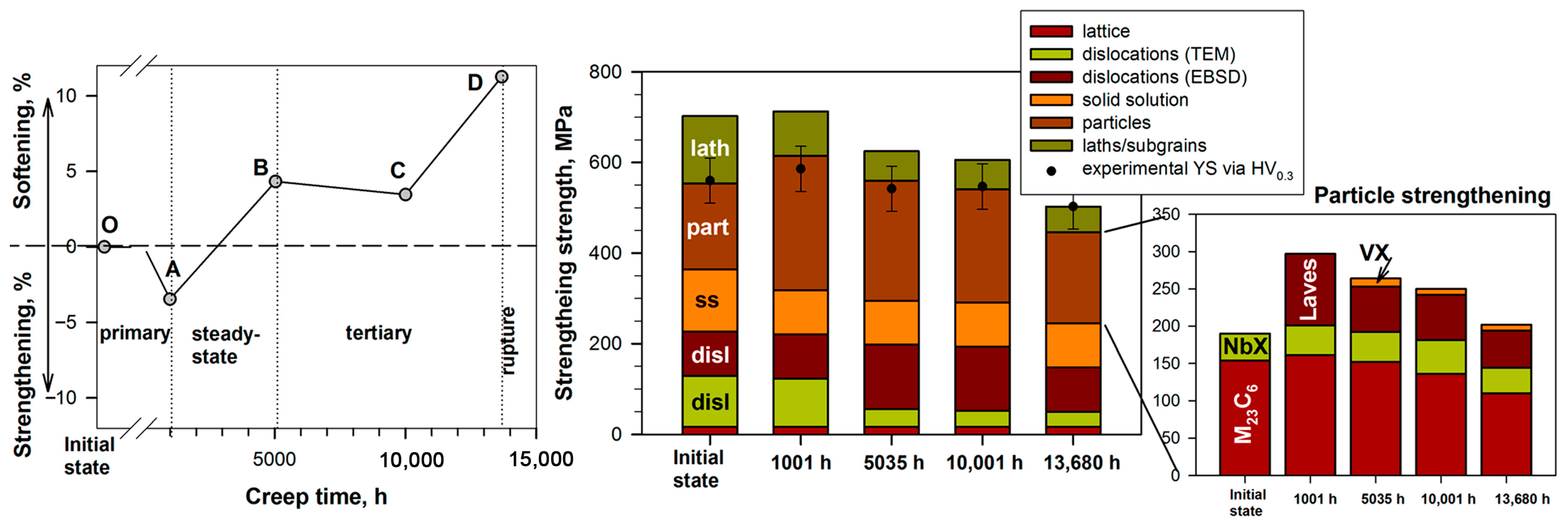
- (i)
- The reduction in dislocation density within the lath interiors (Table 2) decreases their contribution to dislocation strengthening by 2.7 times. On the other hand, the dislocation density inside the lath/subgrain boundaries remains at a high level of 1014 m−2 due to the formation of new subgrain boundaries with low misorientation (Figure 8).
- (ii)
- The growth of the martensitic lath width to 660 ± 30 nm decreases lath/subgrain strengthening by 34%. This is caused by the action of both applied stress and evolution of the grain boundary particles.
- (iii)
- The increase in the mean size of the Laves phase particles decreases their contributions to particle strengthening by 36%.
- (iv)
- The formation of the VX phase slightly increases particle strengthening.
- (i)
- He growth of subgrains due to the applied stress (“new” subgrain boundaries are free from the secondary phase particles) causes the decrease in dislocation density inside the lath/subgrain boundaries due to the reduction in the lath area per unit volume when retaining the average lath/subgrain misorientation of 2.7 deg (Table 2). This provides the decrease in both dislocation strengthening by 29% and lath/subgrain strengthening by 14% (Figure 12).
- (ii)
4.2. The Interactions of Secondary Phase Particles with Lath Boundaries amd Dislocations
- Zener retarding force from grain boundary particles
- Detachment stress of dislocation from an attractive particle after finishing the climb
5. Conclusions
- The TMLS in the tempered state is characterized by the small width of the martensitic laths of 290 ± 30 nm and high dislocation density within the lath interiors of (2.0 ± 0.5) × 1014 m−2 and inside the lath boundaries of (1.5 ± 0.1) × 1014 m−2. The TMLS is stabilized by the M23C6 carbides with a mean size of 67 ± 10 nm, NbX carbonitrides with a mean size of 37 ± 10 nm, and M6C carbides with a mean size of 28 ± 5 nm.
- During the primary creep stage, strengthening of the TMLS is caused by the fine Laves phase particles with a mean size of 110 ± 10 nm that compensate the decrease in solid solution strengthening due to the decrease in W content in the ferrite. These fine Laves phase particles provide a high Zener retarding force of 0.025 MPa in the interactions with the LABs of the martensitic laths and detachment stress of 26 MPa in the interactions with free dislocations. Here, the Laves phase acts as the effective strengthening phase together with M23C6 carbides.
- During the steady-state creep stage, softening of the TMLS due to the reduction in dislocation density within the lath interiors and degradation in the dispersion of the grain boundary particles located along the LABs is observed; the TMLS is transformed into a subgrain structure. The Laves phase loses its effectiveness as the strengthening phase: both Zener force and detachment stress are dramatically decreased. Retaining of the TMLS is provided by M23C6 carbides only: Zener force is 0.08 MPa and detachment stress is 30 MPa. The precipitation of the VX phase with the mean size of 55 nm does not stabilize the TMLS due to the negligible volume fraction. During the tertiary creep stage up to rupture, the mutual growth of martensitic laths and grain boundary particles located along the LABs leads to softening of the TMLS by 11%.
- The rms sum detachment stress of 40 MPa is the critical value, below which low dislocation density within the lath interiors occurs. Both low dislocation density within the lath interior and the decrease in the detachment stresses from the Laves phase and M23C6 carbides are considered to be the origin of the appearance of the creep strength breakdown.
Author Contributions
Funding
Data Availability Statement
Acknowledgments
Conflicts of Interest
References
- Abe, F.; Kern, T.U.; Viswanathan, R. Creep Resistant Steels; Woodhead Publishing: Cambridge, UK, 2008; p. 700. [Google Scholar]
- Kern, T.-U.; Staubli, M.; Scarlin, B. The European efforts in material development for 650 °C USC power plants—COST522. ISIJ Int. 2002, 42, 1515–1519. [Google Scholar] [CrossRef]
- Bhadeshia, H.K.D.H. Design of ferritic creep-resistant steels. ISIJ Int. 2001, 41, 626–640. [Google Scholar] [CrossRef]
- Morito, S.; Adachi, Y.; Ohba, T. Morphology and crystallography of sub-blocks in ultra-low carbon lath martensite steel. Mater. Trans. 2009, 50, 1919–1923. [Google Scholar] [CrossRef]
- Maruyama, K.; Sawada, K.; Koike, J. Strengthening mechanisms of creep resistant tempered martensitic steel. ISIJ Int. 2001, 41, 641–653. [Google Scholar] [CrossRef]
- Sklenička, V.; Kuchařová, K.; Kvapilová, M.; Kloc, L.; Dvořák, J.; Král, P. High-Temperature creep tests of two creep-resistant materials at constant stress and constant load. Key Eng. Mater. 2019, 827, 246–251. [Google Scholar] [CrossRef]
- Sawada, K.; Sekido, K.; Kimura, K. Segregation and its effect on creep rupture strength in Grade 92 steels. Mater. Charact. 2020, 169, 110581. [Google Scholar] [CrossRef]
- Kostka, A.; Tak, K.-G.; Hellmig, R.J.; Estrin, Y.; Eggeler, G. On the contribution of carbides and micrograin boundaries to the creep strength of tempered martensite ferritic steels. Acta Mater. 2007, 55, 539–550. [Google Scholar] [CrossRef]
- Knezevic, V.; Balun, J.; Sauthoff, G.; Inden, G.; Schneider, A. Design of martensitic/ferritic heat-resistant steels for application at 923 K with supporting thermodynamic modeling. Mater. Sci. Eng. A 2008, 477, 334–343. [Google Scholar] [CrossRef]
- Wang, H.; Kostka, A.; Goosen, W.E.; Eggeler, G.; Westraadt, J.E. TEM replica analysis of particle phases in a tempered martensite ferritic Cr steel after long term creep. Mater. Charact. 2018, 181, 111396. [Google Scholar] [CrossRef]
- Maruyama, K.; Sekido, N.; Yoshimi, K. Changes in strengthening mechanisms in creep of 9Cr-1.8W-0.5Mo-VNb steel tested over wide ranges of creep conditions. Int. J. Press. Vessels Pip. 2021, 190, 104312. [Google Scholar] [CrossRef]
- Isik, M.I.; Kostka, A.; Eggeler, G. The nucleation of Laves phase particles during high-temperature exposure and creep of tempered martensite ferritic steels. Acta Mater. 2014, 81, 230–240. [Google Scholar] [CrossRef]
- Abe, F.; Tabuchi, M.; Tsukamoto, S. Alloy design of MARBN for boiler and turbine applications at 650 °C. Mater. High Temp. 2021, 38, 306–321. [Google Scholar] [CrossRef]
- Abe, F. Precipitate design for creep strengthening of 9%Cr tempered martensitic steel for ultra-supercritical power plants. Sci. Technol. Adv. Mater. 2008, 9, 013002. [Google Scholar] [CrossRef]
- Zhou, X.; Xu, Z.; Shen, Y.; Shen, Y.; Shi, T.; Huang, X. Identification of precipitate phases in an 11%Cr Ferritic/ martensitic steel after short-term creep. ISIJ Int. 2018, 58, 1467–1473. [Google Scholar] [CrossRef]
- Pöpperlová, J.; Wipp, D.; Kuhn, B.; Bleck, W. Laves phase precipitation behavior in HiperFer (High Performance Ferritic) steel with and without boron alloying. Metals 2023, 13, 235. [Google Scholar] [CrossRef]
- Hou, W.; Liu, X.; Fan, P.; Zhu, L.; Zhang, K.; Wang, K.; Wang, L. High-temperature creep life prediction of 9% Cr steel based on creep cavitation modelling. Mater. High Temp. 2022, 39, 122–132. [Google Scholar] [CrossRef]
- Verma, A.; Hawk, J.; Romanov, V.; Carter, J. Predictions of long-term creep life for the family of 9–12 wt% Cr martensitic steels. J. Alloys Compd. 2020, 815, 152417. [Google Scholar] [CrossRef]
- Jiang, C.; Dong, Z.; Song, X.; Jia, J.; Xiang, Z. Long-term creep rupture strength prediction for a new grade of 9Cr martensitic creep resistant steel (G115)—An application of a new tensile creep rupture model. J. Mater. Res. Technol. 2020, 9, 5542–5548. [Google Scholar] [CrossRef]
- Xiao, B.; Yadav, S.; Zhao, L.; Tang, Z.; Han, Y.; Yang, X.; Kai, J.; Yang, T.; Xu, L. Deep insights on the creep behavior and mechanism of a novel G115 steel: Micromechanical modeling and experimental validation. Int. J. Plast. 2021, 147, 103124. [Google Scholar] [CrossRef]
- Dong, Z.; Chen, L.; Xiang, Z. Design of a new 11Cr martensitic steel and evaluation of its long-term creep rupture strengths. J. Mater. Res. Technol. 2022, 20, 3450–3455. [Google Scholar] [CrossRef]
- Danielsen, H.K. Review of Z phase precipitation in 9–12 wt-%Cr steels. Mater. Sci. Technol. 2016, 32, 126–137. [Google Scholar] [CrossRef]
- Westraadt, J.; Goosen, W.; Kostka, A.; Wang, H.; Eggeler, G. Modified Z-phase formation in a 12% Cr tempered martensite ferritic steel during long-term creep. Mater. Sci. Eng. A 2022, 855, 143857. [Google Scholar] [CrossRef]
- Hald, J. High-alloyed martensitic steel grades for boilers in ultra-supercritical power plants. In Materials for Ultra-Supercritical and Advanced Ultra-Supercritical Power Plants; Di Gianfrancesco, A., Ed.; Woodhead Publishing: Cambridge, MA, USA, 2017; pp. 77–97. [Google Scholar] [CrossRef]
- Armaki, H.G.; Chen, R.; Kano, S.; Maruyama, K.; Hasegawa, Y.; Igarashi, M. Strain-induced coarsening of nanoscale precipi-tates in strength enhanced high Cr ferritic steels. Mater. Sci. Eng. A 2012, 532, 373–380. [Google Scholar] [CrossRef]
- Braun, M.; Sawada, K.; Kimura, K. Microstructural changes around grain boundary after long-term creep in low-alloy steels. Int. J. Press. Vessels Pip. 2020, 186, 104162. [Google Scholar] [CrossRef]
- Fedoseeva, A.; Nikitin, I.; Tkachev, E.; Mishnev, R.; Dudova, N.; Kaibyshev, R. Effect of alloying on the nucleation and growth of Laves phase in the 9–10%Cr-3%Co martensitic steels during creep. Metals 2021, 11, 60. [Google Scholar] [CrossRef]
- Fedoseeva, A.; Nikitin, I.; Dudova, N.; Kaibyshev, R. Nucleation of W-rich carbides and Laves phase in a Re-containing 10% Cr steel during creep at 650 °C. Mater. Charact. 2020, 169, 110651. [Google Scholar] [CrossRef]
- Fedoseeva, A.; Nikitin, I.; Dudova, N.; Kaibyshev, R. Coarsening of Laves phase and creep behaviour of a Re-containing 10% Cr-3% Co-3% W steel. Mater. Sci. Eng. A 2021, 812, 141137. [Google Scholar] [CrossRef]
- Dudova, N.; Mishnev, R.; Kaibyshev, R. Creep behavior of a 10%Cr heat-resistant martensitic steel with low nitrogen and high boron contents at 650 °C. Mater. Sci. Eng. A 2019, 766, 138353. [Google Scholar] [CrossRef]
- Fedoseeva, A.; Tkachev, E.; Kaibyshev, R. Advanced heat-resistant martensitic steels: Long-term creep deformation and fracture mechanisms. Mater. Sci. Eng. A 2023, 862, 144438. [Google Scholar] [CrossRef]
- Dudova, N.; Plotnikova, A.; Molodov, D.; Belyakov, A.; Kaibyshev, R. Structural changes of tempered martensitic 9%Cr-2%W-3%Co steel during creep at 650 °C. Mater. Sci. Eng. A 2012, 534, 632–639. [Google Scholar] [CrossRef]
- Hughes, D.; Hansen, N. Microstructure and strength of nickel at large strains. Acta Mater. 2000, 48, 2985–3004. [Google Scholar] [CrossRef]
- Kubin, L.; Mortensen, A. Geometrically necessary dislocations and strain-gradient plasticity: A few critical issues. Scr. Mater. 2003, 48, 119–125. [Google Scholar] [CrossRef]
- Abe, F. Coarsening behavior of lath and its effect on creep rates in tempered martensitic 9Cr-W steels. Mater. Sci. Eng. A 2004, 387–389, 565–569. [Google Scholar] [CrossRef]
- Mikami, M. Effects of dislocation substructure on creep deformation behavior in 0.2%C-9%Cr steel. ISIJ Int. 2016, 56, 1840–1846. [Google Scholar] [CrossRef]
- Dudko, V.; Belyakov, A.; Kaibyshev, R. Evolution of lath substructure and internal stresses in a 9% Cr steel during creep. ISIJ Int. 2017, 57, 540–549. [Google Scholar] [CrossRef]
- Zhang, H.; Subhash, G.; Jing, X.; Kecskes, L.; Dowding, R. Evaluation of hardness–yield strength relationships for bulk metallic glasses. Philos. Mag. Lett. 2006, 86, 333–345. [Google Scholar] [CrossRef]
- Fedoseeva, A.; Nikitin, I.; Dudova, N.; Kaibyshev, R. Effect of normalizing and tempering on structure and mechanical properties of advanced martensitic 10% Cr–3% Co–0.2% Re steel. AIP Conf. Proc. 2017, 1909, 020049. [Google Scholar] [CrossRef]
- Smith, D.; Hehemann, R. The influence of structural parameters on the yield strength of tempered martensite and lower bainite. J. Iron Steel Inst. 1971, 209, 476–485. [Google Scholar] [CrossRef]
- Taylor, G. The mechanism of plastic deformation of crystals: Part I.—Theoretical. Proc. R. Soc. Lond. Ser. A 1934, 145, 362–388. [Google Scholar]
- Li, Q. Modeling the microstructure-mechanical property relationship for a 12%Cr-2W-V-Mo-Ni power plant steel. Mater. Sci. Eng. A 2003, 361, 385–391. [Google Scholar] [CrossRef]
- Lacy, C.; Gensamer, M. The tensile properties of alloyed ferrites. Trans. ASM 1944, 9, 118–125. [Google Scholar]
- Humphreys, F.J.; Hatherly, M. Recrystallization and Related Annealing Phenomena, 2nd ed.; Pergamon Press: Oxford, UK, 2004. [Google Scholar]
- Langford, G.; Cohen, M. Strain hardening of iron by severe plastic deformation. ASM Trans. 1969, 62, 623–638. [Google Scholar]
- Chen, R.; Armaki, H.; Maruyama, K.; Igarashi, M. Long-term microstructural degradation and creep strength in Gr.91 steel. Mat. Sci. Eng. A 2011, 528, 4390–4394. [Google Scholar] [CrossRef]
- Fedoseeva, A.; Dudova, N.; Kaibyshev, R. Creep strength breakdown and microstructure evolution in a 3%Co modified P92 steel. Mat. Sci. Eng. A 2016, 654, 1–12. [Google Scholar] [CrossRef]
- Arzt, E.; Rösler, J. The kinetics of dislocation climb over hard particles—II. Effects of an attractive particle-dislocation interaction. Acta Metall. 1988, 36, 1053–1060. [Google Scholar] [CrossRef]
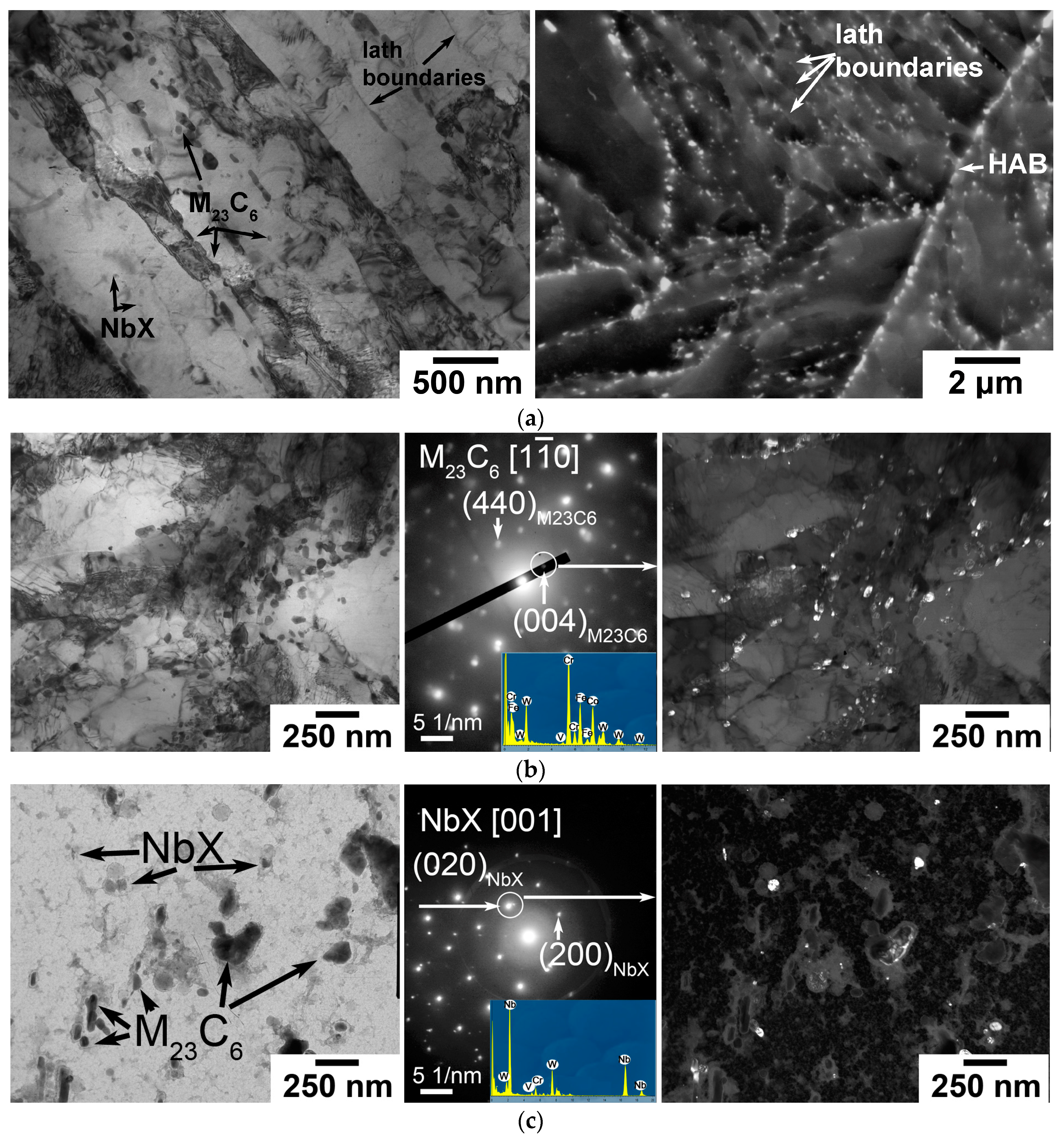


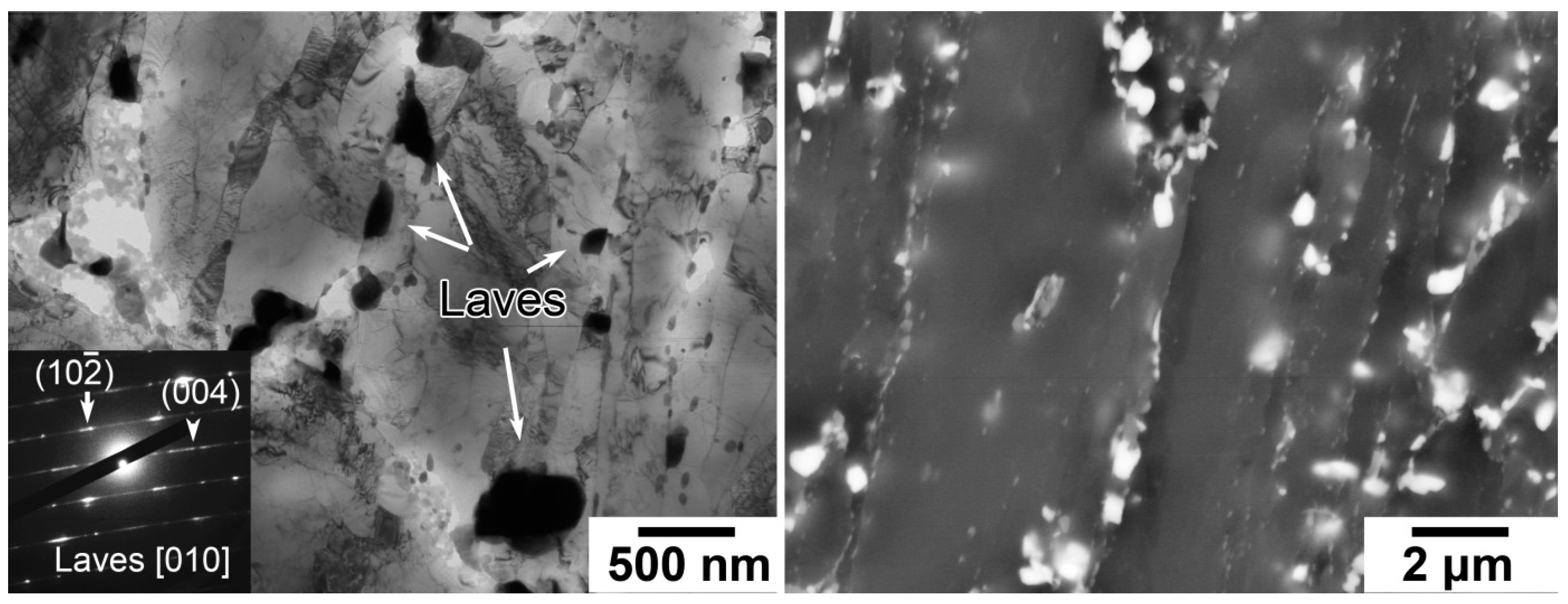




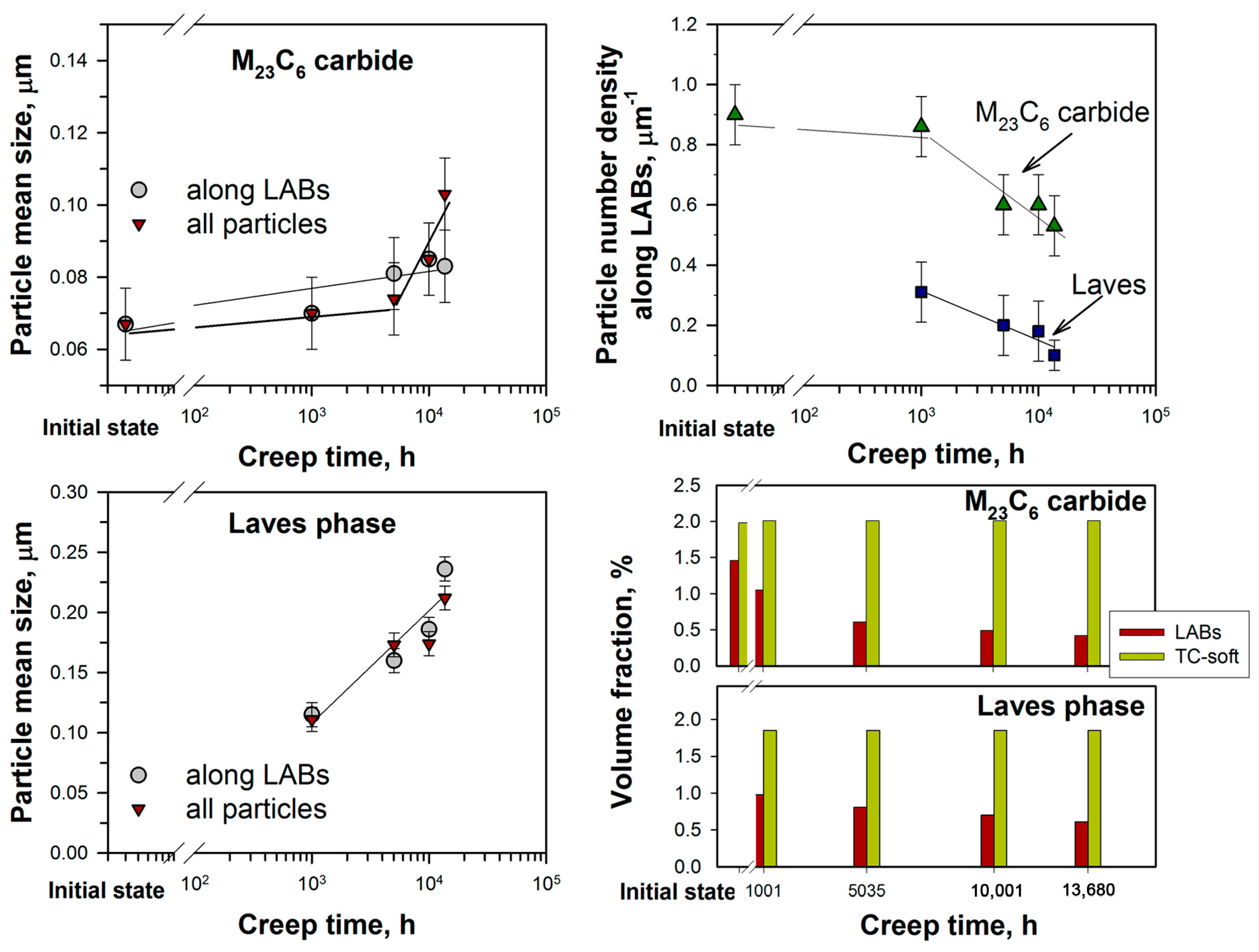
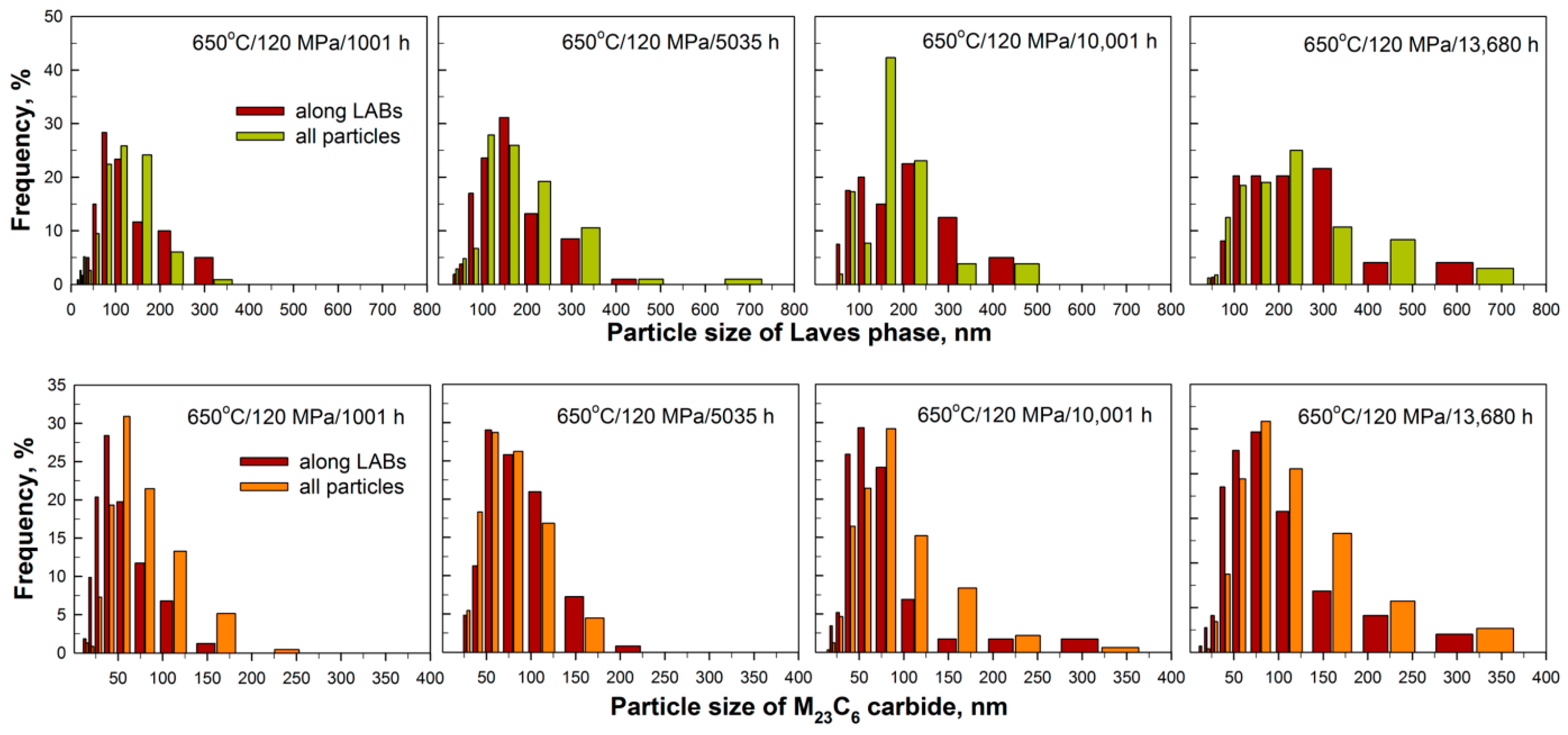
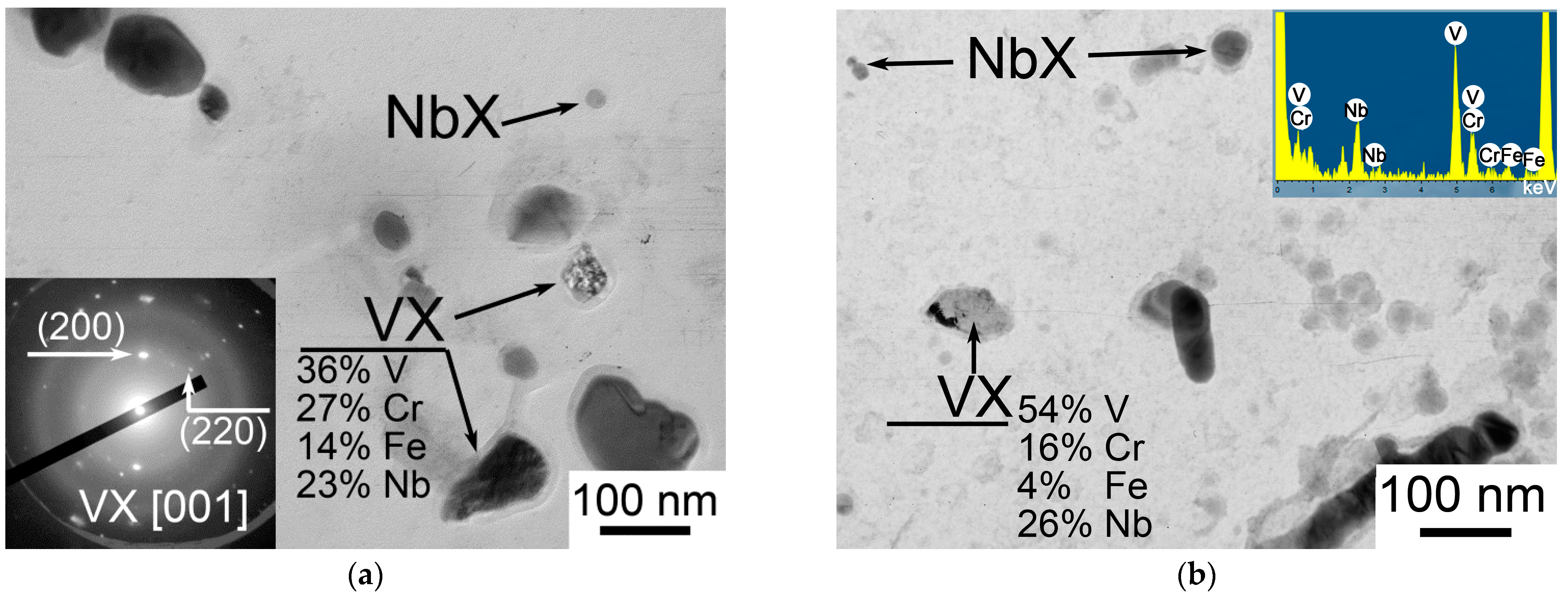
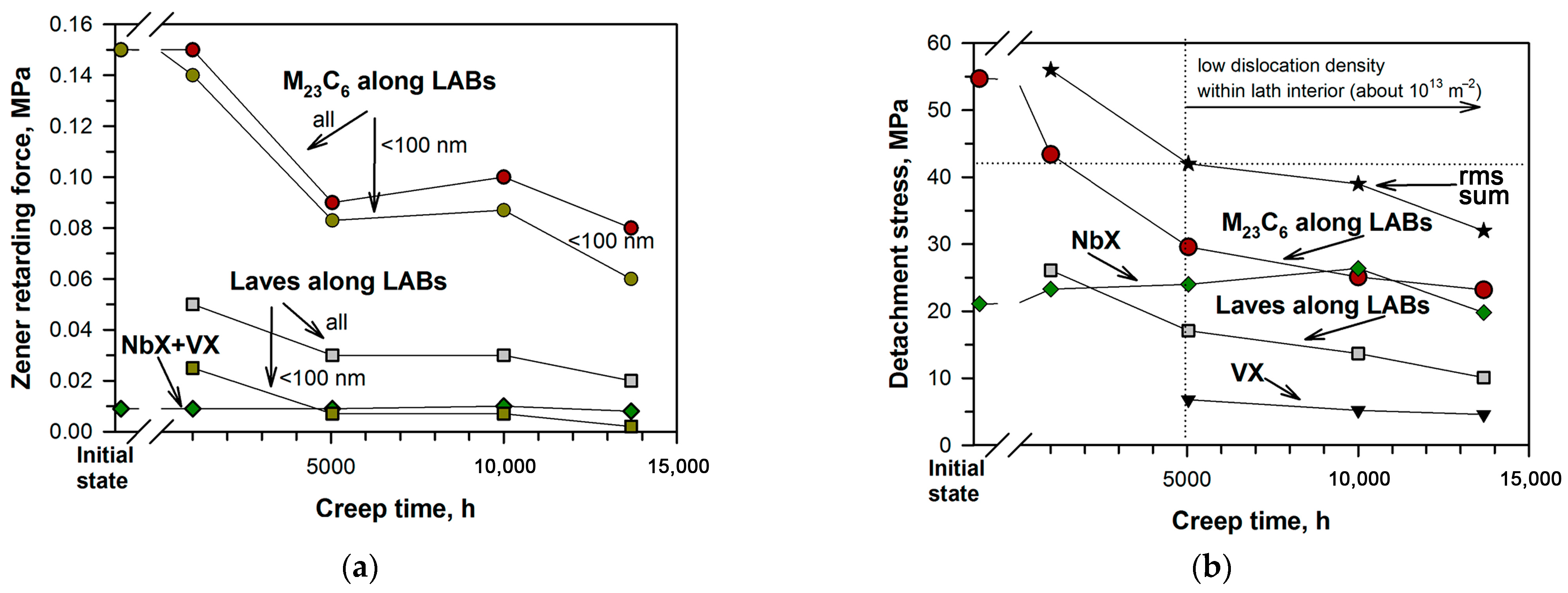
| Phase | Space Group | Bravias Lattice Type | Lattice Parameters, nm |
|---|---|---|---|
| M23C6 | Fmm | Face-centered cubic | a = 1.0656 |
| NbC | Fmm | Face-centered cubic | a = 0.44698 |
| M6C (Fe3W3C) | Fdm | Face-centered cubic | a = 1.1087 |
| Laves (Fe2W) | P6(3)/mmc | Hexagonal | a = 0.4727; c = 0.7704 |
| VN | Fmm | Face-centered cubic | a = 0.413916 |
| Structural Parameters | Tempered | Creep (1%; 1001 h) | Creep (2%; 5035 h) | Creep (2.2%; 10,001 h) | Creep (8.4%; 13,860 h) | Aged 13,860 h | |
|---|---|---|---|---|---|---|---|
| Lath width, nm | 290 ± 30 | 440 ± 30 | 660 ± 30 | 930 ± 30 | 950 ± 30 | 350 ± 30 | |
| Subgrain size, nm | – | 165 ± 30 | 430 ± 30 | 660 ± 30 | 760 ± 30 | – | |
| Dislocation density within the lath interiors (TEM), ×1014 m−2 | 2.0 ± 0.5 | 1.8 ± 0.5 | 0.2 ± 0.05 | 0.2 ± 0.05 | 0.2 ± 0.05 | 1.6 ± 0.5 | |
| Block size, μm | 2.5 ± 0.3 | 3.1 ± 0.3 | 3.1 ± 0.3 | 2.9 ± 0.3 | 3.4 ± 0.3 | – | |
| , ×103 m−1 | 524 | 528 | 508 | 1148 | 532 | – | |
| , deg | 2.80 | 2.73 | 2.87 | 2.64 | 2.70 | – | |
| Dislocation density inside the lath boundaries (EBSD), ×1014 m−2 | 1.5 ± 0.1 | 1.5 ± 0.1 | 1.5 ± 0.1 | 3.2 ± 0.1 | 1.5 ± 0.1 | – | |
| Mean KAM value, deg | 0.626 | 0.627 | 0.609 | 0.811 | 0.624 | – | |
| Dislocation density via KAM, ×1014 m−2 | 8.8 ± 0.1 | 8.8 ± 0.1 | 8.6 ± 0.1 | 11.4 ± 0.1 | 8.8 ± 0.1 | – | |
| M23C6 | Size (all), nm | 67 ± 10 | 70 ± 10 | 74 ± 10 | 83 ± 10 | 103 ± 10 | 80 ± 10 |
| Size (LAB), nm | 69 ± 10 | 70 ± 10 | 81 ± 10 | 85 ± 10 | 85 ± 10 | 66 ± 10 | |
| Volume fraction along LABs, % | 1.5 ± 0.1 | 1.1 ± 0.1 | 0.6 ± 0.1 | 0.5 ± 0.1 | 0.4 ± 0.1 | 1.2 ± 0.1 | |
| Volume fraction *, % | 1.98 | 2.01 | |||||
| Laves | Size (all), nm | – | 111 ± 10 | 173 ± 10 | 174 ± 10 | 212 ± 10 | 197 ± 10 |
| Size (LAB), nm | – | 115 ± 10 | 160 ± 10 | 186 ± 10 | 236 ± 10 | 214 ± 10 | |
| Volume fraction along LABs, % | – | 1.0 ± 0.1 | 0.8 ± 0.1 | 0.7 ± 0.1 | 06 ± 0.1 | 1.1 ± 0.1 | |
| Volume fraction *, % | – | 1.85 | |||||
| M6C | Size, nm | 28 ± 5 | – | ||||
| NbX | Size, nm | 37 ± 10 | 34 ± 10 | 33 ± 10 | 30 ± 10 | 40 ± 10 | 40 ± 10 |
| Volume fraction *, % | 0.077 | 0.068 | |||||
| VX | Size, nm | – | – | 55 ± 10 | 72 ± 10 | 80 ± 10 | – |
| Volume fraction *, % | – | – | 0.0153 | – | |||
| Conditions of the Creep Tests | 1 Interrupted Creep Test | 2 Interrupted Creep Test | 3 Interrupted Creep Test | Creep Test to Rupture |
|---|---|---|---|---|
| Time, h | 1001 | 5035 | 10,001 | 13,860 |
| Strain, % | 1.0 | 2.0 | 2.2 | 8.4 |
| , s−1 | 1.5 × 10−10 | 1.5 × 10−10 | 5.5 × 10−10 | – |
| Header Conditions of the Creep Tests | Equilibrium Lath Width, μm | Equilibrium Lath Width Taking into Account Grain Boundary Particles with Sizes < 100 nm Only, μm | Experimental Lath Width, μm |
|---|---|---|---|
| Tempered | 0.49 | 0.49 | 0.29 ± 0.03 |
| 1001 h, 1% | 0.36 | 0.44 | 0.44 ± 0.03 |
| 5035 h, 2% | 0.57 | 0.76 | 0.66 ± 0.03 |
| 10,001 h, 2.2% | 0.55 | 0.73 | 0.93 ± 0.03 |
| 13,860 h, 8.4% | 0.73 | 1.11 | 0.95 ± 0.03 |
Disclaimer/Publisher’s Note: The statements, opinions and data contained in all publications are solely those of the individual author(s) and contributor(s) and not of MDPI and/or the editor(s). MDPI and/or the editor(s) disclaim responsibility for any injury to people or property resulting from any ideas, methods, instructions or products referred to in the content. |
© 2023 by the authors. Licensee MDPI, Basel, Switzerland. This article is an open access article distributed under the terms and conditions of the Creative Commons Attribution (CC BY) license (https://creativecommons.org/licenses/by/4.0/).
Share and Cite
Fedoseeva, A.; Brazhnikov, I.; Degtyareva, S.; Nikitin, I.; Kaibyshev, R. Microstructural Evolution of a Re-Containing 10% Cr-3Co-3W Steel during Creep at Elevated Temperature. Metals 2023, 13, 1683. https://doi.org/10.3390/met13101683
Fedoseeva A, Brazhnikov I, Degtyareva S, Nikitin I, Kaibyshev R. Microstructural Evolution of a Re-Containing 10% Cr-3Co-3W Steel during Creep at Elevated Temperature. Metals. 2023; 13(10):1683. https://doi.org/10.3390/met13101683
Chicago/Turabian StyleFedoseeva, Alexandra, Ivan Brazhnikov, Svetlana Degtyareva, Ivan Nikitin, and Rustam Kaibyshev. 2023. "Microstructural Evolution of a Re-Containing 10% Cr-3Co-3W Steel during Creep at Elevated Temperature" Metals 13, no. 10: 1683. https://doi.org/10.3390/met13101683
APA StyleFedoseeva, A., Brazhnikov, I., Degtyareva, S., Nikitin, I., & Kaibyshev, R. (2023). Microstructural Evolution of a Re-Containing 10% Cr-3Co-3W Steel during Creep at Elevated Temperature. Metals, 13(10), 1683. https://doi.org/10.3390/met13101683






